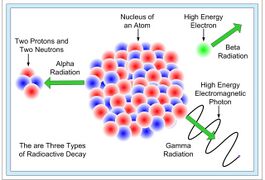Law of radioactive decay
The law of radioactive decay describes quantitatively the decay in a large set of radioactive elements. Mathematically, the law is formulated as follows:
where N is the number of atoms in the given sample at time t , N 0 is the number of atoms at time t=0 and λ is the decay constant. The decay constant is related to the often used half-life in the following way:
The half-life characterizes the respective isotope. It is a constant that can be considered constant with very good reliability despite common physical influences such as pressure, temperature or the chemical environment of the respective isotope. Its value ranges from fractions of a second to thousands of years.
Prerequisites[edit | edit source]
The law is derived under simplifying assumptions. Some just make the derivation easier, in the next step it can be shown that dropping them only leads to slightly more complex shapes. Others are based on physical ideas about nuclear decay as a physical event. Their justification rests on the one hand in the deeper principles of nuclear physics and on the other hand in the fact that the results predicted by the law of radioactive decay are in very good agreement with the experiment.
The assumptions facilitating the derivation are:
- At the beginning of the monitoring, there are only N identical atoms of the relevant isotope in the studied volume.
- The respective isotope decays by only one type of nuclear decay.
The assumptions based on the physical nature of nuclear decay are:
- Nuclear decay is an irreversible event. Once the nucleus has broken down, it does not "compose".
- Core decay is a random event. The probability that a given nucleus will decay at a given moment does not depend on the previous time, it is constant at any time (when it has not yet decayed). The assumption of independence from the past is somewhat counterintuitive. The best idea for a non-physicist is that the nucleus of the radioisotope in question, without any signs of "stress and cracking", waits until it decays out of nothing.
Derivation[edit | edit source]
Several procedures can be used for derivation. Each of them is based on the application of the basis of the infinitesimal calculus and, more implicitly or more explicitly, the basis of the probability calculus.
Let us first assume only one atom. The probability that it will break up is the same at any given time, it is only proportional to the length of that interval. Thus, for an infinitely short time interval d t , the probability p of the decay of a particular atom is determined as:
, where λ is the proportionality constant. This constant is referred to as the decay constant and has the meaning of a constant characterizing the decay rate.
Now suppose there are N particles in the set. The mean value, i.e. the vaguely average number of particles that decay in the system in time d t , is given simply:
For a very high value of N , the dispersion is negligible, so it can be written that in an infinitesimally small time dt , the same (infinitely few) nuclei dN decay each time . Since it is quite naturally assumed that the nuclei will decay, a minus sign appears in the relation:
The above relation is an ordinary differential equation that can be modified as follows (this method of solving ordinary differential equations is called the method of separation of variables; equations that can be solved in this way are called separable):
and then simply integrate:
Determining the limits of integration is a matter of the theory of differential equations. Visually, it can be imagined by integrating on the left side of the equation from the initial number of particles N 0 to the current number of particles N , then on the right over the corresponding time. After integrating both sides of the equation and making a simple adjustment, the result will be:
The above-mentioned differential equation is sometimes referred to as the law of radioactive decay, but usually only this simple equation.
Decay constant and half-life[edit | edit source]
The decay constant λ fully describes the decay rate. Because it is less illustrative, the half-life T 1/2 is usually used , which tells how long it takes for the amount of an isotope in a given sample to halve. Since both the decay constant and the half-life describe the same property, there is a definite relationship between them that can be derived as follows:
Let there be initially N 0 atoms in the sample . After the half-time T 1/2 has passed, there are N 1 =N 0 /2 atoms in the sample from the definition . Of course:
Continuing both sides of the equation, we get:
Since there are positive values on both sides of the equation, both sides of the equation can be logarithmized:
Using the basic properties of logarithms, the relationship can be modified:
And so:
Links[edit | edit source]
Related Articles[edit | edit source]
- radioactivity
- Excretion of radioactive substances by the organism
- A radionuclide
- alpha decay
- beta decay
Literature[edit | edit source]
- HRAZDIRA, Ivo – MORNSTEIN, Vojtěch. Lékařská biofyzika a přístrojová technika. 1. edition. Neptun, 2001. 396 pp. ISBN 80-902896-1-4.
- HÁLA, Jiří. Radioaktivita, ionizující záření, jaderná energie. 1. edition. Konvoj, 1998. 312 pp. ISBN 80-85615-56-8.












